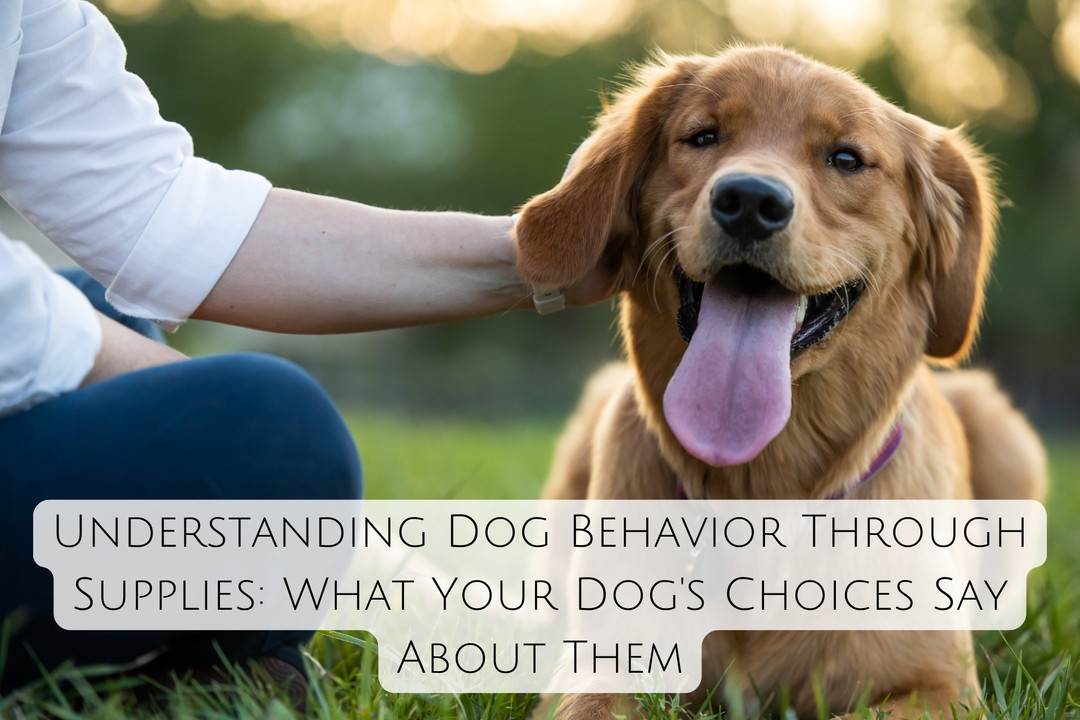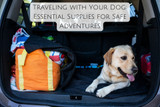Understanding Dog Behavior Through Supplies: What Your Dog's Choices Say About Them
Dogs, much like humans, have unique personalities, preferences, and ways of interacting with the world around them. One fascinating way to understand your dog better is through the supplies they choose and how they engage with their toys, beds, food bowls, and other items. Every preference, from the type of toy they favor to their sleeping habits, can provide insight into their personality, emotional needs, and overall well-being. Here’s a closer look at what your dog’s choices might reveal.
Toys: Insights into Energy Levels and Play Style:
The toys your dog gravitates toward can reveal a lot about their temperament, intelligence, and activity level.
- Chew Toys: Dogs who are big on chew toys are often independent and highly focused. Chewing can be a comforting activity for dogs, especially those with a strong need to relieve anxiety or excess energy. Breeds with strong jaws, like Pit Bulls and Rottweilers, may also gravitate towards these toys due to their natural instinct to chew.
- Fetch Toys: Dogs who love fetch toys, like tennis balls or Frisbees, are generally high-energy and social. These dogs often enjoy interactive play and crave companionship. Breeds like Labradors, Retrievers, and Border Collies are natural fetchers, showing a love for outdoor activity and a willingness to please.
- Puzzle Toys: Puzzle-loving dogs often display signs of intelligence and curiosity. These toys are ideal for dogs that enjoy mental stimulation and problem-solving, such as Poodles, German Shepherds, and Australian Shepherds. A dog who prefers these toys might benefit from additional mental challenges and training to keep them engaged.
- Stuffed or Soft Toys: Some dogs carry around plush toys as if they’re their “babies.” This can signify a nurturing side, especially in breeds that are naturally protective, like Dachshunds or Spaniels. Other dogs might love to tear apart plush toys, revealing a strong prey drive.
Beds: Preferences in Comfort and Security:

Where and how your dog likes to sleep can provide clues to their sense of security, comfort needs, and personality.
- : Dogs who prefer memory foam or orthopedic beds may be prioritizing comfort, especially if they’re older or larger breeds prone to joint issues, like Great Danes or Golden Retrievers. This choice could also indicate that they value a quiet, undisturbed place to rest.
- Cuddler or Bolster Beds: Dogs who prefer beds with raised edges may enjoy feeling enclosed and protected, which can be especially comforting for small breeds or anxious dogs. These beds mimic a den-like structure, offering security for dogs who crave coziness.
- Flat or Cooling Mats: High-energy dogs or those with thick coats, like Huskies or Malamutes, might enjoy cooling mats to regulate their body temperature. Dogs that stretch out when they sleep may also prefer open, flat beds that allow them to sprawl.
- Crates: Some dogs love their crates and consider them a safe retreat. A crate-loving dog may enjoy having a “den” space that’s all their own, where they can go to decompress or nap undisturbed. This choice is common in dogs who are naturally independent or feel the need for a dedicated safe space.
Food and Water Bowls: Patterns and Pacing:
The way a dog interacts with their food and water bowls offers insight into their feeding preferences, level of excitement, and sometimes even physical traits.
- Elevated Bowls: Certain breeds, like Great Danes and Bulldogs, benefit from elevated bowls, which can make eating more comfortable and reduce strain on their necks. A preference for elevated bowls can also indicate a fast eater; raised bowls can help with digestion for those who tend to gulp down their food.
- Slow Feeder Bowls: Dogs who eat too quickly can benefit from slow feeder bowls, which contain obstacles that make eating more of a challenge. These dogs tend to be enthusiastic eaters, sometimes from a background of food insecurity, and may be prone to bloating or digestion issues without pacing.
- Ceramic or Stainless Steel Bowls: Some dogs show a preference for particular materials. Stainless steel bowls are often a favorite because they don’t hold onto odors like plastic does and are easy to clean. For dogs with allergies, stainless steel or ceramic can be a good choice, as they are non-porous and don’t harbor bacteria.
- Water Fountain Bowls: Some dogs are more enticed by moving water, which could be a holdover from their instincts to prefer running water. Dogs with longer coats, like Collies or Retrievers, may prefer these to keep water cooler, and certain breeds with short noses, like Pugs and Bulldogs, find drinking from fountains more comfortable.
Collars, Leashes, and Harnesses: Comfort vs. Control:

How your dog responds to different walking equipment can tell you a lot about their energy level, walking habits, and level of socialization.
- Collar Preference: Dogs that walk well on a collar are usually comfortable with basic training and don’t tend to pull. These dogs may do better with harnesses that distribute pressure evenly.
- Harness Preference: High-energy dogs or those prone to pulling may feel more secure in a harness, which can offer more control without placing strain on the neck. Harnesses are particularly popular with breeds like Greyhounds, who have delicate necks, or strong pullers like Huskies.
- Retractable Leash: Some dogs enjoy the freedom of a retractable leash, showing curiosity and independence by exploring their surroundings. However, these leashes are best for dogs with good recall and socialization, as they allow the dog more freedom to explore.
- Head Collars: For particularly strong or reactive dogs, head collars are often recommended. Dogs that respond well to head collars are typically calm and focused but may need additional control on walks, especially if they’re easily excited or distracted.
Grooming Supplies: Sensitivity and Comfort:
Grooming tools your dog is most comfortable with can give you clues about their skin sensitivity and grooming tolerance.
- Brush Types: Dogs with sensitive skin might prefer softer brushes, like rubber brushes, that provide a gentler experience. Conversely, double-coated dogs, like Golden Retrievers or Huskies, benefit from deshedding tools that reach through the thick fur to remove loose hair.
- Nail Clippers vs. Grinders: Some dogs tolerate nail clippers, while others respond better to grinders, which are slower but offer more precision. A dog who’s skittish about loud noises might avoid grinders, while those with thicker nails may appreciate the efficiency of a clipper.
- Shampoo Preferences: Dogs with skin allergies or sensitivities may require hypoallergenic or medicated shampoos. If your dog seems itchy or irritated after baths, it might be a sign they need a gentler product.
Training Equipment: Insights into Personality and Response to Commands:
Training aids, such as clickers, treats, and whistles, can reveal how your dog learns and responds to commands.
- Clickers: Dogs who respond well to clicker training tend to be motivated by clear, quick feedback. This technique is often effective for dogs with high intelligence and a strong drive to learn, such as Border Collies or Poodles.
- Treat Dispensers: Some dogs are highly food-motivated and will eagerly work for treats from a dispenser. This approach works well with breeds like Beagles or Dachshunds, which tend to be highly treat-driven and respond well to food-based rewards.
- Whistles and Remote Trainers: Dogs that work well with whistles, especially those used for outdoor recall or hunting, tend to be focused and have a high drive for working alongside humans. Breeds like Labradors and Coonhounds, bred for outdoor work, respond well to these tools.
Final Thoughts:
Observing your dog’s choices in toys, beds, bowls, and grooming tools can provide valuable insights into their unique personality, preferences, and behavioral traits. By understanding these preferences, you can tailor your approach to their care, improving their well-being and strengthening your bond. Whether you have a high-energy fetch lover, a cautious cuddler, or an independent explorer, paying attention to their chosen supplies can give you clues to their needs and help you provide the best environment possible for a happy, healthy dog.
Latest Blogs
Traveling with Your Dog: Essential Supplies for Safe Adventures
Traveling with your dog can be an incredibly rewarding experience, whether you’re heading to a new c...
Understanding Blade Angles: How They Affect Performance and Usage
Blade angle, often referred to as "bevel angle," plays a critical role in the efficiency and versati...
The Best Power Tools for Home Renovation: A Comprehensive Guide
Embarking on a home renovation project is exciting, but it’s also a big undertaking that requires th...
Tech in the Garden: The Rise of Smart Gardening Tools
Gardening has traditionally been a relaxing, nature-centric hobby, but with recent advancements in t...
Tech in the Garden: The Rise of Smart Gardening Tools
Gardening has traditionally been a relaxing, nature-centric hobby, but with recent advancements in t...
Security Lighting and Motion Detectors: An Underrated Defense Mechanism
When it comes to home security, many people focus on locks, alarms, and surveillance cameras. Howeve...










